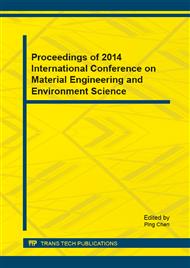[1]
Zhang X J, Qiao G J, Zhang X, Effect of Mg doping on the microstructure and properties of α-Al2O3 transparent ceramics. Applied Mechanics and Materials. 66 (2011) 1264-1269.
DOI: 10.4028/www.scientific.net/amm.66-68.1264
Google Scholar
[2]
Yin Z, Huang C, Zou B, et al, Study of the mechanical properties, strengthening and toughening mechanisms Al2O3/TiC micro-nano-composite ceramic tool material Materials Science and Engineering: A. 577 (2013) 9-15.
DOI: 10.1016/j.msea.2013.04.033
Google Scholar
[3]
Chlup Z, Flasar P, Kotoji A, et al, Fracture behaviour of Al2O3/SiC nanocomposite ceramics after crack healing treatment. Journal of the European Ceramic Society. 28 (2008) 1073-1077.
DOI: 10.1016/j.jeurceramsoc.2007.09.007
Google Scholar
[4]
Xu X H, Zhao F, Wu J F, et al, Research on microstructre and thermal shock behaviour of Al2O3/SiC composite ceramics used in solar thermal power. Journal of Wuhan University of Technology, 31 (2009) 8-11.
DOI: 10.1007/s11595-011-0214-4
Google Scholar
[5]
Zhang X F, Yu G Q , Jiang L W, Application of Alumina Ceramic. Foshan Ceramics. 20 (2010) 38-43.
Google Scholar
[6]
Guo X Z, Li W Y, Yang H, et al. Microstructure and property of andalusite based corundum-mullite duplex ceramics. China Ceramic Industry. 17 (2010) 6-9.
Google Scholar
[7]
Reimanis I, Kleebe H J, A review on the sintering and microstructure development of transparent spinel (MgAl2O4). Journal of the American Ceramic Society. 92 (2009) 1472-1480.
DOI: 10.1111/j.1551-2916.2009.03108.x
Google Scholar
[8]
Aksel C, Warren P D, Riley F L, Fracture behaviour of magnesia and magnesia-spinel composites before and after thermal shock. Journal of the European Ceramic Society. 24 (2004) 2407-2416.
DOI: 10.1016/j.jeurceramsoc.2003.07.005
Google Scholar
[9]
Esposito L, Piancastelli A, Martelli S, Production and characterization of transparent MgAl2O4 prepared by hot pressing. Journal of the European Ceramic Society. 33 (2013) 737-747.
DOI: 10.1016/j.jeurceramsoc.2012.10.013
Google Scholar
[10]
Whitney E D, Kinetics and mechanism of the transition of metastable tetragonal to monoclinic zirconia. Transactions of the Faraday Society. 61 (1965) 1991-(2000).
DOI: 10.1039/tf9656101991
Google Scholar
[11]
Chen S G, Yin Y S, Zhou C H, Application and study on mechanism of the phase-stabilized zirconia. Bulletin of the Chinese Ceramic Society. 3 (2004) 73-76.
Google Scholar
[12]
Wang Juntao, Chen Songlin, Yuan Lin, et al, Effect of Zirconia on thermal shock resistance of corundum-spinel castables. Journal of The Chinese Ceramic Society. 39 (2011) 1317-1322.
Google Scholar
[13]
Majidian H, Ebadzadeh T and Salahi E. Effect of SiC additions on microstructure, mechanical properties and thermal shock behaviour of alumina-mullite-zirconia composites Materials Science and Engineering A. 530 (2011) 585-590.
DOI: 10.1016/j.msea.2011.10.027
Google Scholar
[14]
Awaad M, Zawrah M F, Khalil N M, In situ formation of zirconia-alumina-spinel-mullite ceramic composites. Ceramics International. Ceramics International. 34 (2008) 429-434.
DOI: 10.1016/j.ceramint.2006.11.002
Google Scholar


